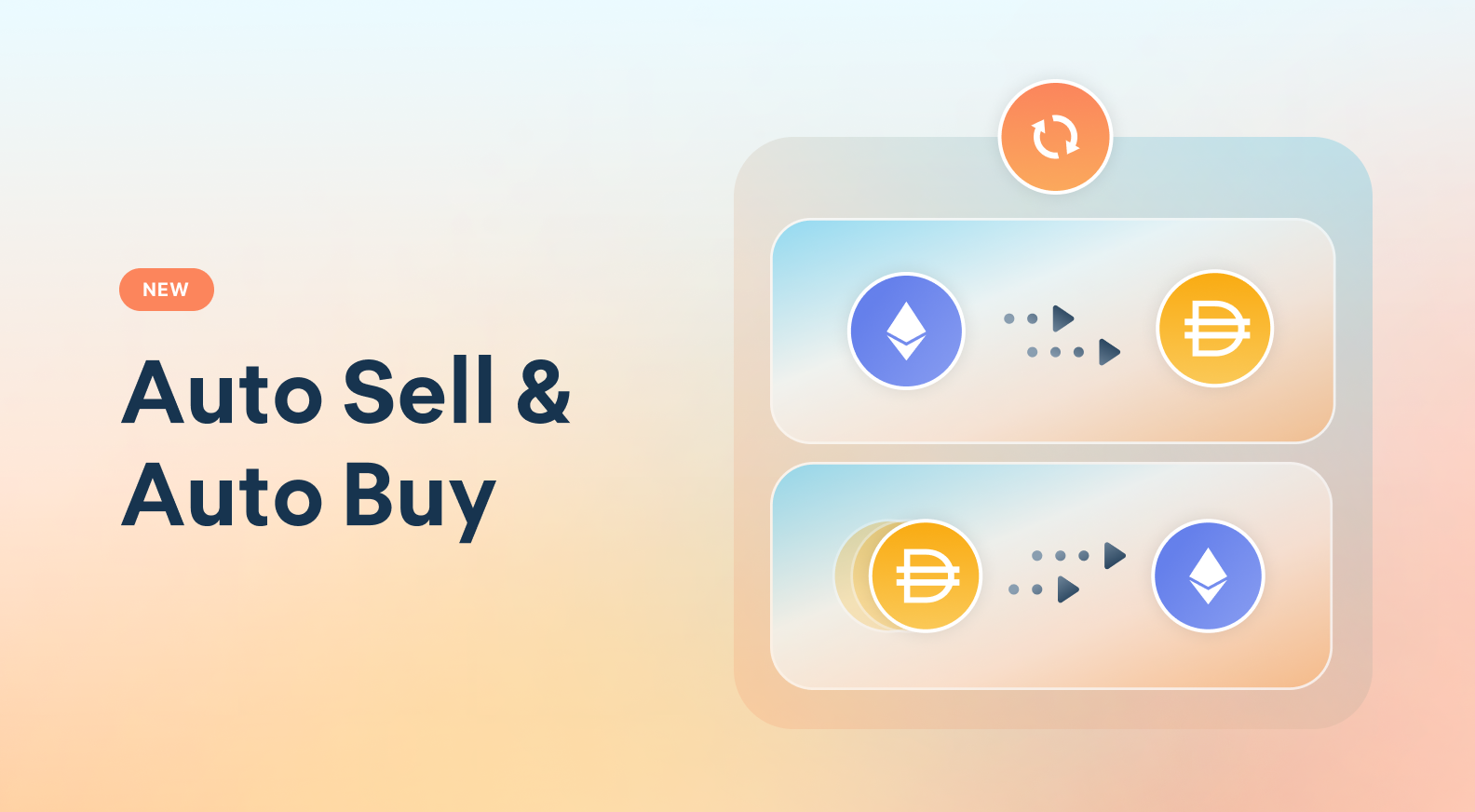Summer.fi Launches New Automation Features For Your Vaults: Auto-Buy & Auto-Sell

Today we are happy to release some new features, which represent another step towards providing you with the best tools to implement your strategy while deploying your capital into DeFi.
Auto-Buy and Auto-Sell allow you to manage your vault’s collateralization ratio automatically.
With a few clicks, you can create an automation strategy that executes at the trigger point set by you, moving your vault's collateralization ratio to the target set by you.
Auto-Buy allows you to reduce your vault’s collateralization ratio by generating more DAI which is swapped for collateral and deposited into your vault.
Auto-Sell allows you to do the opposite. Auto-Sell automatically repays your vault debt, increasing the collateralization ratio and de-risking your vault.
Let’s look at each of these in more detail.
Auto-Buy
You can use Auto-Buy to keep your vault’s collateralization ratio below a certain level. This may be beneficial, for example, in a bull market where the value of your collateral is increasing.
Say you might want to keep your collateralization ratio below 240%, whenever that trigger is hit, it automatically generates more DAI and swaps it for collateral. This gives you increased exposure to the collateral asset.
How can I use it?
Setting up your Auto-Buy is easy, just choose four required parameters:
- Trigger Ratio: This is the collateralization ratio that, when hit, will trigger the execution of your Auto-Buy.
- Target Ratio: This is the collateralization ratio that is going to be achieved by executing the Auto-Buy. For Auto-Buy, the Target Ratio is always lower than the Trigger Ratio.
- Note: the Auto-Buy will be eligible for execution if it can achieve the Target Ratio +/- 2%.
- Max Buy Price: When you execute an Auto-Buy you generate DAI to buy collateral, which is deposited into your vault. Here you are setting the maximum price that you are willing to pay for that collateral. As Auto-buy is a recursive strategy, it will continue to execute each time your trigger ratio is hit and the buy price remains below your max buy price.
- Max Gas Fee: Here you select the maximum gas fee that you are willing to spend each time your Auto-Buy executes. If the gas fee is above your max gas fee, the Auto-Buy will remain active but will not execute until the network gas fees are reduced.
How does it work under the hood?
If your vault’s collateralization ratio hits the trigger at 240%, the Auto-Buy will execute and generate more DAI from your vault. This DAI will be swapped for your collateral asset, which will then be deposited into your vault. This increases your exposure to the collateral asset and will recursively buy more as the price increases.
As this is a recursive strategy, every time your trigger is hit, the Auto-buy will execute.
This means that the trigger remains in place after the execution.
In the example above, after the Auto-Buy executes for the first time, the collateralization ratio is now at 200%, but the trigger remains active at 240%. If the value of your collateral continues to increase, your collateralization ratio will also increase towards that trigger. And if it hits 240% the Auto-buy will execute again! This will continue to happen until the price of the collateral goes above your max buy price.
Auto-Sell
Auto Sell is the opposite strategy to Auto-Buy as it will keep your vault’s collateralization ratio above a certain level. This may be beneficial, in a bear market where the value of your collateral is decreasing. Not only does it decrease your exposure to the asset when the price is falling, but it also de-risks your vault by keeping the collateralization ratio away from your Stop-Loss of liquidation threshold.
Say your vault’s collateralization ratio is 250%, and you want to set up an automated strategy that protects your vault from liquidation without closing your vault. You could set up an Auto-Sell trigger that will execute at 175% with a target ratio of 210%.
How can I use it?
Setting up your Auto-Sell is very similar to Auto-Buy , just choose four required parameters:
- Trigger Ratio: This is the collateralization ratio that, when hit, will trigger the execution of your Auto-Sell.
- Target Ratio: This is the collateralization ratio that is going to be achieved by executing your Auto-Sell. For Auto-Sell, the target ratio is always higher than the Trigger Ratio.
Note: the Auto-Sell will be eligible for execution if it can achieve the Target Ratio +/- 2%. - Min. Sell Price: When you execute an Auto-Sell you are selling your collateral to DAI to repay the vault debt. Here you are setting the minimum collateral price that you are willing to sell your collateral at when you execute your Auto-Sell. As Auto-Sell is a recursive strategy, the Auto-Sell will continue to execute each time your trigger ratio is hit and the sell price remains above your minimum sell price.
- Max Gas Fee: Here you select the maximum gas fee that you are willing to spend each time your Auto-Sell executes. If the gas fee is above your max gas fee, the Auto-Sell will remain active but will not execute until the network gas fees reduce.
How does it work under the hood?
If your vault’s collateralization ratio hits the trigger at 175%, the Auto-Sell will execute and swap the required amount of your collateral to DAI. The DAI will be used to repay the required amount of debt on your vault to bring the collateralization ratio up to the target ratio of 210%.
Like Auto-Buy, this happens recursively, so every time your trigger is hit, the Auto-Sell will execute.
The trigger remains in place after the execution. After the first execution that we took in the example above, the collateralization ratio is now at 210%, but the trigger remains active at 175%. If the value of your collateral continues to drop, your collateralization ratio will drop back towards that trigger. And if it hits 175% the Auto-sell will execute again! This protects your vault from liquidation and keeps your vault open, unlike our Stop-loss protection which protects you from liquidation by executing once and closing your vault.
Can I use Automation Strategies Together?
Absolutely! On a single vault you can set up an Auto-Buy, an Auto-Sell and a Stop-Loss.
This allows you to completely automate your collateralization ratio in both up and down markets, as well as automatically protecting your vault from liquidation.
Here’s an example.
You set up an Auto-Buy to trigger at a collateralization ratio of 300%, bringing it back down to a target of 250%. This gives you increased exposure to your collateral asset in a bullish market.
You also set an Auto-Sell to trigger at a collateralization ratio of 200% bringing it back up to a target of 250%. This reduces your exposure in a bearish market.
And as a final protection in a bear market you set up Stop Loss protection at 180% to close out your vault in the event of a rapid drop in price. In this example it will only execute if the price drop goes through both your Auto-sell trigger and your stop-loss trigger in one price update. The Stop-loss protection will close out your vault to DAI or collateral before it is liquidated.
At this point you may be concerned about causing a cascade of automated transactions, as one’s target ratio hits another’s trigger ratio. We thought of that, and have handled it with dynamic limits to the parameters that you set, preventing an accidental cascade.
The Auto-Sell functionality is limited by the minimum vault debt. This means that you can’t set up an Auto-Sell that will take you past your dust limit. Additionally, as this is a recursive strategy, if at some point of time the execution of Auto-Sell will leave your Vault’s debt below your minimum, (it will not be executed and your Vault will be at risk of liquidation / your Vault will be automatically closed).
What is Recursive Automation?
Auto-Buy and Auto-Sell are both recursive automation strategies. Unlike Stop-Loss Protection which executes only once, when the trigger ratio is hit, recursive automation strategies can be executed multiple times.
This is because the trigger remains in place after the strategy has executed. Let’s take an example using Auto-Sell.
Initially you set up your Auto-Sell on an ETH Vault with the following Parameters:
- Trigger Ratio: 190%
- Target Ratio: 220%
- Min. Sell price: $800 /ETH
- Max Gas fee: 200GWEI
Your Auto-Sell will execute every time your vault’s collateralization ratio hits the trigger ratio, until the price of the collateral is less than your minimum sell price.
- The vault’s collateralization ratio hits the trigger for the 1st time. Causing your Auto-Sell to execute and bring the col. ratio back up to 220%.
- The price of the ETH keeps dropping, decreasing your col. Ratio again.
- The trigger of 190% is hit for a second time. It executes and brings the col. ratio back up to 220%.
- The price of the ETH is dropping further, decreasing your col. ratio again.
- The price of ETH is now $790/ETH. The trigger of 190% is hit for a third time. But this time, it does not execute the auto sell as the ETH price is below your min. Sell price.
This scenario illustrates what could happen in a significantly bearish market for ETH. Each time the price drops and the trigger is hit, the Auto-Sell executes to reduce your exposure to ETH and move your col. Ratio away from the liquidation ratio. Remember, you can always add a Stop-Loss to your vault as a final protection against liquidation. This needs to be added below your Auto-Sell trigger ratio.
Please Note: Automation isn't guaranteed to work 100% of the timeSeveral factor can relate to its success. These include liquidity, volatility and gas. Learn more about automation and how Summer is building the best automation product on Ethereum →
Getting help
If you have any questions regarding Summer.fi in general, you contact us at support@summer.fi or on our social media.

